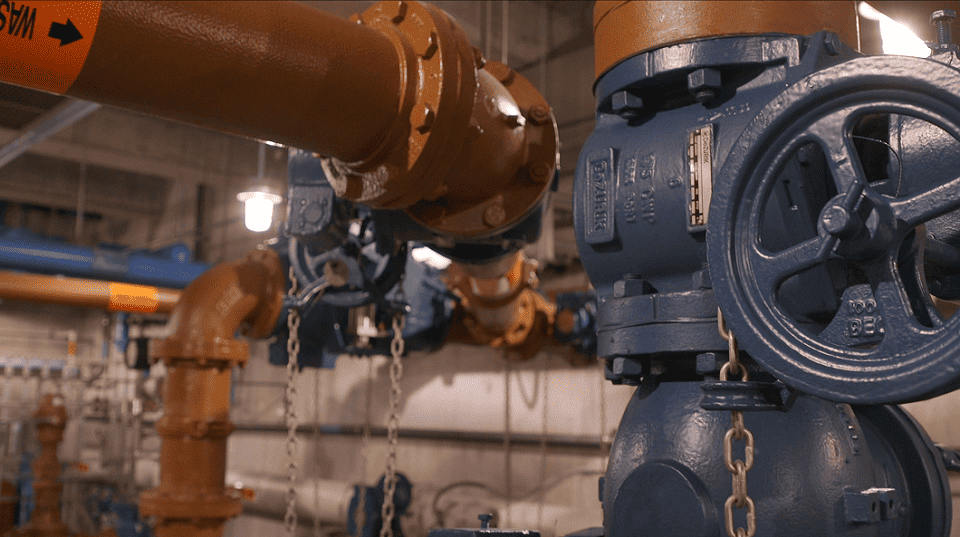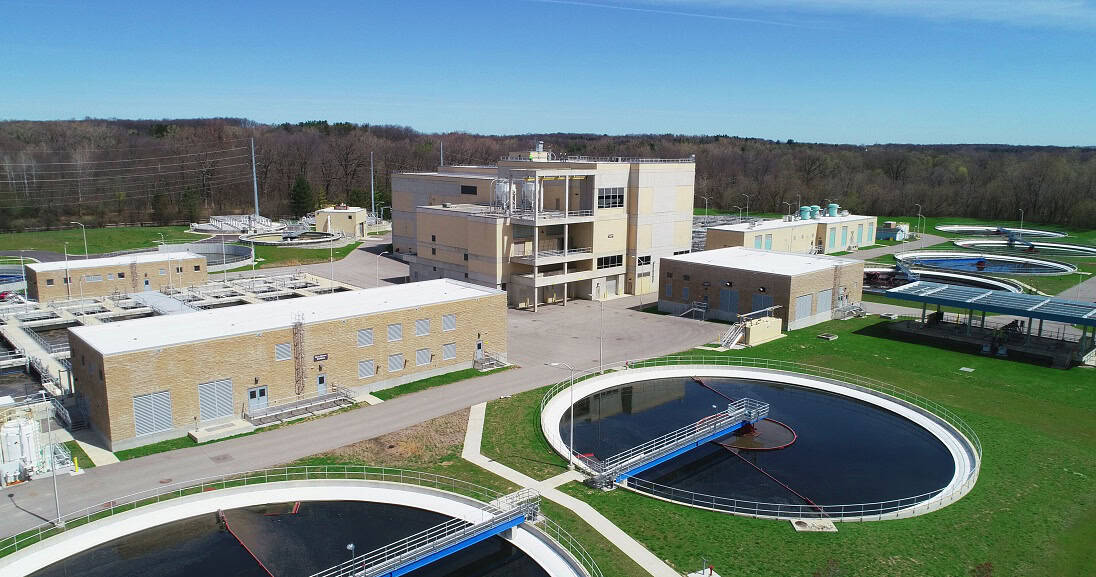
Southeast Michigan is served by publicly- and privately-owned wastewater collection and treatment systems, which include combined and separated sanitary sewer collection systems and onsite sewage disposal systems (septic systems). Approximately eight percent of the region is served by combined sewer systems. All other areas of the region have separated sanitary sewer or onsite sewage disposal systems.
Combined Sewer Overflows
In a combined sewer system, both wastewater and stormwater runoff are collected in the same infrastructure system. During certain rain events, stormwater takes up capacity in the sewer, causing the combined sewage to back-up into basements and overflow into rivers, lakes, and streams. Addressing combined sewer overflows is a priority for the region with respect to wastewater infrastructure. Since 1988, the number of uncontrolled CSOs in the region has declined from 310 to 76. The 23 remaining suburban CSOs will be corrected by 2025, along with a goal to correct high-priority outfalls in the City of Detroit by 2037.
Onsite Sewage Disposal Systems
A third type of system used in more rural areas is Onsite Sewage Disposal Systems (OSDS). These are small-scale treatment systems often used for individual properties. The most common OSDS is a septic tank and drain field combination. As these systems age, and the property changes ownership, it can be difficult for communities to determine if the systems are working properly. Common signs of residential drain field failure include oversaturated ground areas that are devoid of any grass as shown in the photo on the right.
A 2015 Michigan State University study found that OSDS in Michigan are failing to prevent human fecal bacteria from entering the state’s waterways. The research correlated high fecal bacteria in rivers to more septic systems in the watershed. The Michigan Department of Energy and Great Lakes estimates that there are approximately 130,000 failing OSDS currently in use. Michigan is the only state in the country without a uniform septic code. To improve the condition of OSDS, many counties in the region have adopted time-of-sale ordinances in order to inspect the OSDS. Additionally, strengthening maintenance programs and the availability of septic tank sludge (septage) receiving stations also reduce water resource pollution.
Wastewater Treatment Facilities
There are approximately 59 Wastewater Treatment Plants (WWTPs) in Southeast Michigan. These facilities treat and disinfect wastewater before discharging to local waterways. Many of these facilities are transitioning to being recognized as water resource recovery facilities (WRRFs) by including other operations such as recovering nutrients, generating energy, and integrating green infrastructure. WRRFs have additional positive impacts on the region’s environmental, economic, and social outcomes.
One of the operational elements at wastewater treatment plants is to limit the nutrient loading into local waterways. Excess nitrogen and phosphorus can lead to algal blooms, significantly impacting the health of the water body. The Western Lake Erie basin has experienced severe algal blooms over the past several years. Addressing nutrient loading to local waterways has been a state priority since the 1960s.While the state has focused on multiple avenues to reduce nutrient loading, a significant milestone has been achieved in the Detroit River. With a goal of reducing 506 metric tons of phosphorus annually in the Detroit River, the state estimates that over 95 percent of that target reduction has been achieved since 2008. A significant portion of the phosphorus reduction is due to modifications at the GLWA WRRF.

Managing Invasive Species around Lake St. Clair
The Lake St. Clair Cooperative Invasive Species Management Area (CISMA) has been established within the boundary of the Lake St. Clair Watershed in Macomb County, St. Clair County, Oakland County and Wayne County. A CISMA is a partnership-based management structure comprised of representatives of local, regional, state and federal agencies, nongovernmental organizations, property owners and the public.
A CISMA Steering Committee has been established as a subcommittee of the Lake St. Clair/St. Clair River Protection and Restoration Partnership. The Lake St. Clair CISMA will work to manage the spread of five priority invasive species both aquatic and terrestrial across Southeast Michigan’s landscape. The species include:
- Invasive Phragmites (Riparian),
- Black swallow wort (Terrestrial),
- Japanese knotweed (Riparian),
- European frog-bit (Aquatic), and
- Flowering rush (Aquatic).
Source: MISIN (Midwest Invasive Species Information Network)
Invasive Phragmites is the major invasive species target. Phragmites is ubiquitous across the Great Lakes landscape. In 2009, Ducks Unlimited mapped approximately 12,000 acres of Phragmites around Lake St. Clair – predominantly in the Anchor Bay Coastal Marsh Complex. Some 3,500 acres of Phragmites has since been managed at a cost of approximately $1.4 million. It is now estimated that there may be as much as 17,000 acres of Phragmites throughout the Lake St. Clair Watershed.
The Lake St. Clair CISMA was recently awarded $254,000 from the Michigan Department of Natural Resource’s Michigan Invasive Species Grant Program for eradication and control. The CISMA’s 2015 management strategy is comprised of activities that will build the capacity of the organization, stop the spread of invasives as well as enhance its operational performance. These activities include:
- Hiring a CISMA Coordinator to coordinate tasks and seek economies of scale,
- Train volunteers and students on identifying the priority invasives in the field as well as mapping to measure spread,
- Begin management operations on 750 acres around the watershed,
- Develop outreach for implementing the CISMA’s Early Detection and Response program,
- Continue planning for future funding needs, and
- Establish a public education and outreach program to improve the public’s awareness and engagement in mapping and eradication efforts.
Recent Water Resource Publications for the St. Clair/Detroit River System
The publications which follow are planning resources for improving natural resource and source water protection along the Lake St. Clair and Detroit River Connecting Channel System:
Spill Scenario simulations along the Huron to Erie Corridor
According to a 2006 GAO report, 991 reports of spills along the St. Clair/Detroit River System were received by the NRC (National Response Center) between 1994 and 2004. In response to this high number of spills, a system of real-time monitoring equipment was installed in the water treatment plants from Port Huron down to Monroe funded through federal, state, and local means.
In 2009-2010, contaminant spill scenarios were simulated along the St. Clair River in a joint GLOS and NOAA-GLERL initiative (Anderson and Schwab) using the Huron-Erie Corridor Waterway Forecast System, a three-dimensional hydrodynamic model. There were three spill transects used along the St. Clair River — at Sarnia, Marysville, and St. Clair. Each transect had five release locations equally spaced across the river. Two dye releases were made at each release location — one surface (floating) and the other bottom (sinking) — for a total of 30 spill scenarios. The simulations calculated spill characteristics data (pdf, 524KB) such as time of arrival at each of the eight downstream transects (for recording spill parameter data), or at water treatment plants through interpolation, location of plume relative to shoreline, and location of peak plume concentration over time. A graphic-based spill tracking tool (pdf, 1.4MB) for the St. Clair River was developed by NOAA-GLERL for the Water Treatment Plant operators based on data generated in each spill simulation.
Funding has now been secured from the Great Lakes Observing System to complete the spill scenario simulation in Lake St. Clair and the Detroit River. The Michigan Technological Research Institute will conduct the modeling using 3-Dimensional hydrodynamic Huron to Erie Corridor Waterways Forecasting (HECWFS) Model. See funding proposal. This work will take place in the 2018/2019 time frame.
